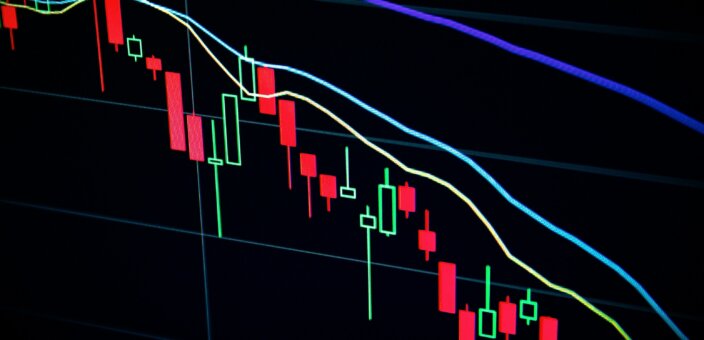Stock market volatility can be unnerving. No investor, whether they’re new to investing or have been making deposits for years, likes to see the value of their portfolio go down—even if it’s just temporary. When the market takes a turn, some people will inevitably sell investments in an attempt to minimize their losses, while others will stop making new deposits to their investment accounts. Unfortunately, both are usually mistakes that can cost you in the long run. Instead, we think you should do nothing. Don’t make any changes to your strategy: Just keep investing on a regular schedule even when the market is down. Why? History shows that markets have behaved predictably in the long run, and investors who stay the course are likely to come out ahead.
We know this can be tough to do, and we want to help. So in this post, we’ll provide some historical perspective on past market downturns so you can feel more confident that you’re doing the right thing for your portfolio, even when markets are turbulent.
Market declines are very common
Market declines can rattle investors, but it’s important to keep in mind that they’re very common. The chart below shows the maximum drawdown (this is the largest loss experienced over a certain time period, expressed as a percentage) of the US stock market every year since 1927 as well as the market’s total return that year. As you can see, large drawdowns (or declines from a recent peak) are extremely common. And you might be surprised to learn that even years with large declines can still yield impressive positive returns for investors at the end of the year.
For example, let’s take a closer look at 2020 when US stocks entered a bear market at the onset of the Covid-19 pandemic. The market had a maximum drawdown of 34.3% that year, which is large even by historical standards. But investors who stuck it out all year were rewarded with a total return of 24.1% by the time the year was over. Of course, in order to get that return, an investor needed to stay in the market and avoid missing the recovery. The lesson here is clear: History shows that if you stayed invested when the market was volatile, you likely came out ahead.
Historically, the market has gone up in the long run
Temporary declines like those in the table above can certainly be nerve-wracking, but if you have a long investing time horizon, they’re just blips on the radar. You can see this clearly if you zoom out and look at the behavior of the US stock market since before the Great Depression: The overall trend is up and to the right.
To help you visualize this, we put together a chart showing the value of a dollar invested in 1926. The point isn’t that you should have invested a dollar nearly 100 years ago (although that would have yielded impressive returns)—it’s that the US stock market has behaved unpredictably in the short term but fairly predictably in the long run. (Note that the scale of the y-axis is logarithmic, not linear, enabling you to see fluctuations more clearly.)
Value of $1 invested in the US stock market 1926-2025
Of course, the last five years have been extraordinary in some ways because of the Covid-19 pandemic. However, those events still haven’t altered the overall trajectory of the market. Below, we’ve zoomed in on the section of the chart covering the last 10 years. As you can see, the overall trend of the broad US stock market is still very clear: It goes up. History has shown that even in the case of a bear market (a decline of 20% or more from a recent high), the market tends to recover much faster than you might think.
Value of $1 invested in the US stock market in 1926, 2015-2025
The bottom line: Market declines are an opportunity
We encourage you to see short-term stock market declines as an opportunity: If you keep putting money in the market, you effectively get to buy investments while they’re “on sale.” Plus, you can help lower the taxes you’ll pay with tax-loss harvesting. Wealthfront offers automated Tax-Loss Harvesting to our clients at no additional cost, which we estimate has saved clients over $1 billion in taxes over the last decade.
Periods of volatility are a good reminder of the importance of diversification—or buying a wide range of investments instead of focusing on a single company, sector, or geography. Diversification can increase your risk-adjusted returns and, to some extent, insulate you from losses. When you feel insulated from losses, it’s easier to stay invested, which is key to investing success.
You might hear people talking about “buying the dip” or waiting until the market bottoms out to begin investing again. This sounds good in theory, but it is hard to do in practice. That’s because in the moment, it’s virtually impossible to tell whether the market has hit bottom or will continue to fall. There’s also the opportunity cost of sitting on uninvested cash waiting for the bottom. Unfortunately, academic research has shown that timing the market doesn’t work—even most professional investors can’t consistently get it right. That’s why we think it’s wise to stick to your investing plan regardless of what the market is doing.
We hope the information in this post helps you feel more confident about staying the course with your investments. We know it’s tough, but you’ll be glad you did.
Disclosure
The information contained in this communication is provided for general informational purposes only, and should not be construed as investment or tax advice. Nothing in this communication should be construed as a solicitation or offer, or recommendation, to buy or sell any security. Any links provided to other server sites are offered as a matter of convenience and are not intended to imply that Wealthfront Advisers or its affiliates endorses, sponsors, promotes and/or is affiliated with the owners of or participants in those sites, or endorses any information contained on those sites, unless expressly stated otherwise.
Investment management and advisory services are provided by Wealthfront Advisers LLC (“Wealthfront Advisers”), an SEC-registered investment adviser, and brokerage related products, including the Cash Account, are provided by Wealthfront Brokerage LLC (“Wealthfront Brokerage”), a Member of FINRA/SIPC. Financial planning tools are provided by Wealthfront Software LLC (“Wealthfront Software”).
The effectiveness of the tax-loss harvesting strategy to reduce the tax liability of the client will depend on the client’s entire tax and investment profile, including purchases and dispositions in a client’s (or client’s spouse’s) accounts outside of Wealthfront Advisers and type of investments (e.g., taxable or nontaxable) or holding period (e.g., short-term or long-term).
Wealthfront Advisers’ investment strategies, including portfolio rebalancing and tax-loss harvesting, can lead to high levels of trading. High levels of trading could result in (a) bid-ask spread expense; (b) trade executions that may occur at prices beyond the bid ask spread (if quantity demanded exceeds quantity available at the bid or ask); (c) trading that may adversely move prices, such that subsequent transactions occur at worse prices; (d) trading that may disqualify some dividends from qualified dividend treatment; (e) unfulfilled orders or portfolio drift, in the event that markets are disorderly or trading halts altogether; and (f) unforeseen trading errors. The performance of the new securities purchased through the tax-loss harvesting service may be better or worse than the performance of the securities that are sold for tax-loss harvesting purposes.
Tax-loss harvesting may generate a higher number of trades due to attempts to capture losses. There is a chance that trading attributed to tax-loss harvesting may create capital gains and wash sales and could be subject to higher transaction costs and market impacts. In addition, tax loss harvesting strategies may produce losses, which may not be offset by sufficient gains in the account and may be limited to a $3,000 deduction against income. The utilization of losses harvested through the strategy will depend upon the recognition of capital gains in the same or a future tax period, and in addition may be subject to limitations under applicable tax laws, e.g., if there are insufficient realized gains in the tax period, the use of harvested losses may be limited to a $3,000 deduction against income and distributions. Losses harvested through the strategy that are not utilized in the tax period when recognized (e.g., because of insufficient capital gains and/or significant capital loss carryforwards), generally may be carried forward to offset future capital gains, if any.
Diversification and automated investing do not guarantee profit or ensure against loss. Investor experiences can vary widely based on strategies and time horizons. Index funds and ETFs generally offer broad diversification, but may still expose investors to specific market, sector, or asset class risks. Wealthfront provides investment management services but may not achieve returns comparable to those of the general market or specific benchmarks.
Wealthfront Advisers, Wealthfront Brokerage, and Wealthfront Software are wholly-owned subsidiaries of Wealthfront Corporation.
Copyright 2025 Wealthfront Corporation. All rights reserved.
About the author(s)
Alex Michalka, Ph.D, has led Wealthfront’s investment research team since 2019. Prior to Wealthfront, Alex held quantitative research positions at AQR Capital Management and The Climate Corporation. Alex holds a B.A. in Applied Mathematics from the University of California, Berkeley, and a Ph.D. in Operations Research from Columbia University. View all posts by Alex Michalka, Ph.D
Leotie Fukawa is a Product Specialist at Wealthfront and a Certified Financial Planner (CFP). She holds Series 66 and Series 7 licenses from FINRA. View all posts by Leotie Fukawa, CFP



